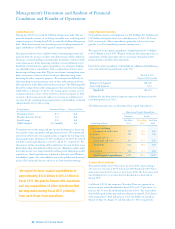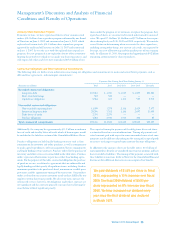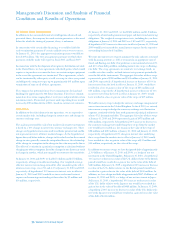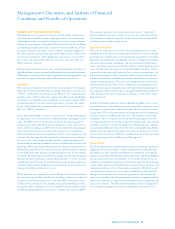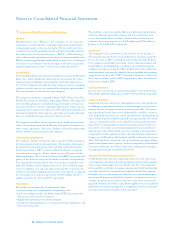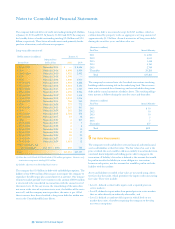Walmart 2010 Annual Report Download - page 36
Download and view the complete annual report
Please find page 36 of the 2010 Walmart annual report below. You can navigate through the pages in the report by either clicking on the pages listed below, or by using the keyword search tool below to find specific information within the annual report.1 Summary of Significant Accounting Policies
General
Wal-Mart Stores, Inc. (“Walmart,” the “company” or “we”) operates
retail stores in various formats around the world and is committed to
saving people money so they can live better. We earn the trust of our
customers every day by providing a broad assortment of quality merchan-
dise and services at every day low prices (“EDLP”) while fostering a
culture that rewards and embraces mutual respect, integrity and diversity.
EDLP is our pricing philosophy under which we price items at a low price
every day so our customers trust that our prices will not change under
frequent promotional activity. Our fiscal year ends on January 31.
Consolidation
The Consolidated Financial Statements include the accounts of Wal-Mart
Stores, Inc. and its subsidiaries. Intercompany transactions have been
eliminated in consolidation. Investments in which the company has a
20% to 50% voting interest and where the company exercises significant
influence over the investee are accounted for using the equity method.
These investments are immaterial to our company.
The company’s operations in Argentina, Brazil, Chile, China, Costa Rica,
El Salvador, Guatemala, Honduras, India, Japan, Mexico, Nicaragua and
the United Kingdom are consolidated using a December 31 fiscal year-
end, generally due to statutory reporting requirements. There were no
significant intervening events in January 2010 which materially affected
the financial statements. The company’s operations in Canada and Puerto
Rico are consolidated using a January 31 fiscal year-end.
The company consolidates the accounts of certain variable interest entities
where it has been determined that Walmart is the primary beneficiary of
those entities’ operations. The assets, liabilities and results of operations
of these entities are not material to the company.
Cash and Cash Equivalents
The company considers investments with a maturity of three months or
less when purchased to be cash equivalents. The majority of payments
due from banks for third-party credit card, debit card and electronic
benefit transactions (“EBT”) process within 24-48 hours, except for
transactions occurring on a Friday, which are generally processed the
following Monday. All credit card, debit card and EBT transactions that
process in less than seven days are classified as cash and cash equivalents.
The amounts due from banks for these transactions classified as cash
totaled $2.6 billion and $2.0 billion at January 31, 2010 and 2009, respec-
tively. In addition, cash and cash equivalents includes restricted cash
related to cash collateral holdings from various counterparties as required
by certain derivative and trust agreements of $469 million and $577
million at January 31, 2010 and 2009, respectively.
Receivables
Receivables consist primarily of amounts due from:
• insurance companies resulting from our pharmacy sales;
• banks for customer credit card, debit card and EBT transactions that
take in excess of seven days to process;
• suppliers for marketing or incentive programs;
• consumer financing programs in certain international subsidiaries; and
• real estate transactions.
We establish a reserve for uncollectible receivables based on historical
trends in collection of past due amounts and write-off history. Our
reserve for uncollectible receivables, which relates primarily to our
consumer financing programs, was $298 million and $188 million at
January 31, 2010 and 2009, respectively.
Inventories
The company values inventories at the lower of cost or market as
determined primarily by the retail method of accounting, using the
last-in, first-out (“LIFO”) method for substantially all of the Walmart
U.S. segment’s merchandise inventories. Sam’s Club merchandise and
merchandise in our distribution warehouses are valued based on the
weighted-average cost using the LIFO method. Inventories of Interna-
tional operations are primarily valued by the retail method of accounting,
using the first-in, first-out (“FIFO”) method. At January 31, 2010 and
2009, our inventories valued at LIFO approximate those inventories as
if they were valued at FIFO.
Capitalized Interest
Interest costs capitalized on construction projects were $85 million,
$88 million and $150 million in fiscal 2010, 2009 and 2008, respectively.
Long-Lived Assets
Long-lived assets are stated at cost. Management reviews long-lived assets
for indicators of impairment whenever events or changes in circumstances
indicate that the carrying amount may not be recoverable. The evalua-
tion is performed at the lowest level of identifiable cash flows, which is
at the individual store level or in certain circumstances a market group of
stores. Undiscounted cash flows expected to be generated by the related
assets are estimated over the asset’s useful life based on updated projec-
tions. If the evaluation indicates that the carrying amount of the asset
may not be recoverable, any potential impairment is measured based
upon the fair value of the related asset or asset group as determined by
an appropriate market appraisal or other valuation technique. Impairment
charges were $429 million, $262 million and $210 million for fiscal years
2010, 2009 and 2008, respectively, and are classified in operating, selling,
general and administrative expenses on the accompanying Consolidated
Statements of Income. See Note 15 for further information regarding
the impairment charges recorded in fiscal 2010.
Goodwill and Other Acquired Intangible Assets
Goodwill represents the excess of purchase price over fair value of net
assets acquired, and is allocated to the appropriate segment when acquired.
Other acquired intangible assets are stated at the fair value acquired as
determined by a valuation technique commensurate with the intended
use of the related asset. Goodwill and indefinite-lived other acquired
intangible assets are not amortized; rather they are evaluated for impair-
ment annually during our fourth fiscal quarter, or whenever events or
changes in circumstances indicate that the value of the asset may be
impaired. Definite-lived other acquired intangible assets are considered
long-lived assets and are amortized on a straight-line basis over the periods
that expected economic benefits will be provided.
Notes to Consolidated Financial Statements
34 Walmart 2010 Annual Report


